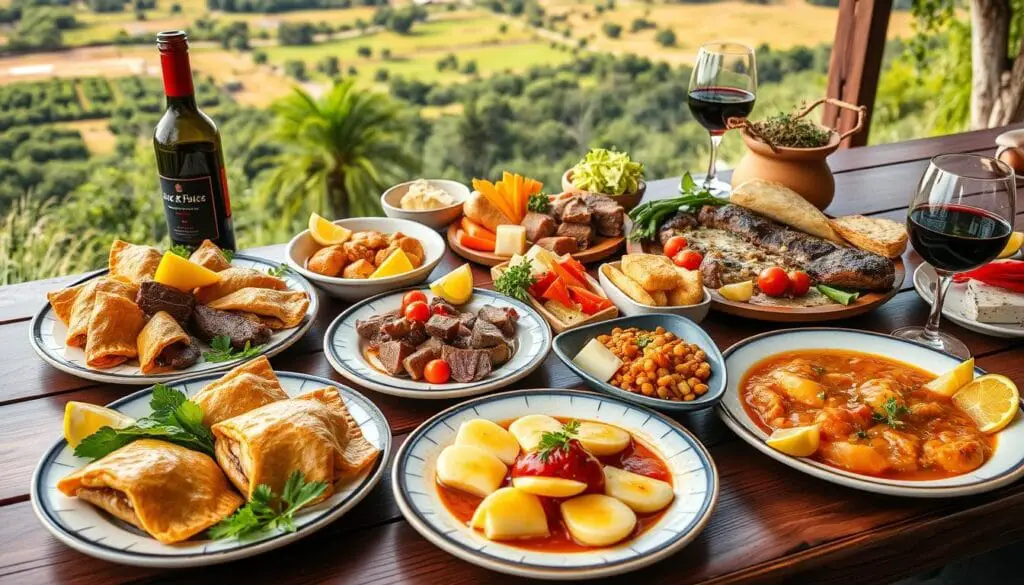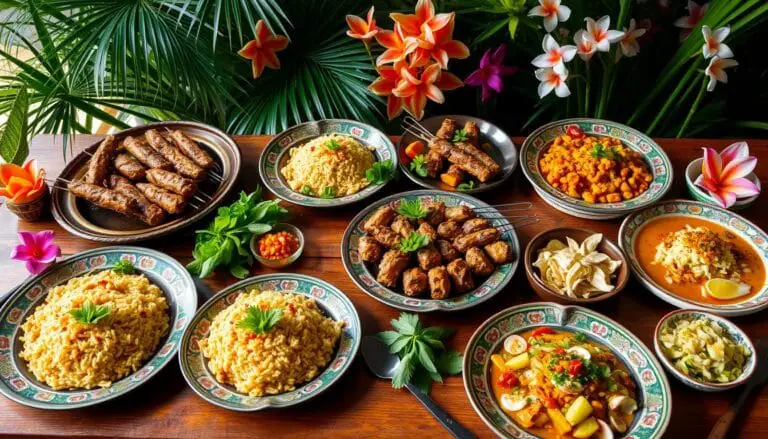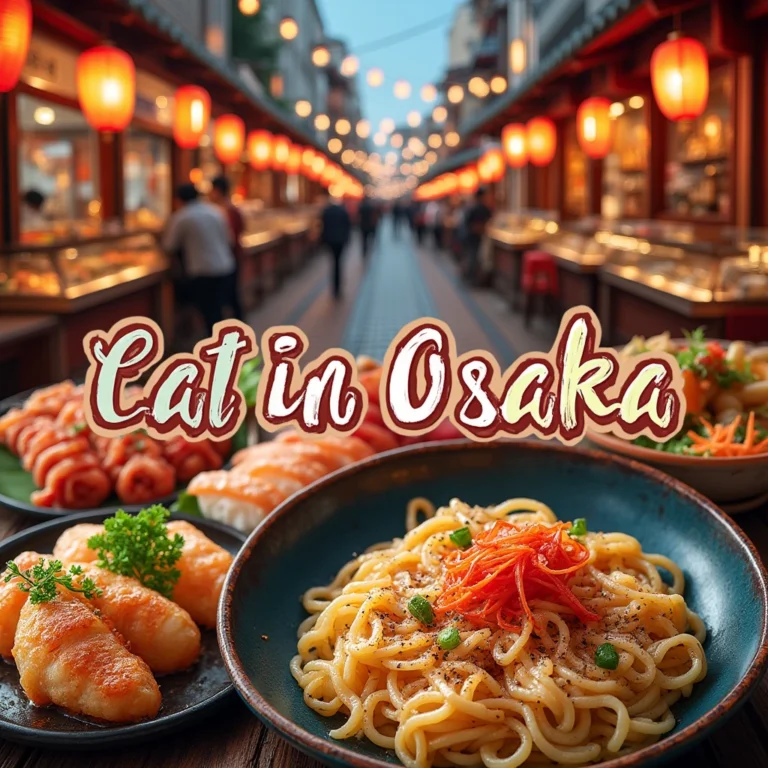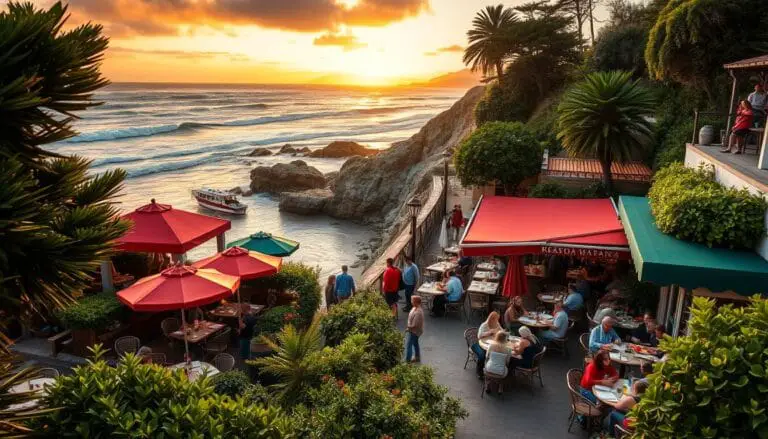Argentina Cuisine: 10 Irresistible Delights That Will Steal Your Heart
This site contains affiliate links . At no additional cost to you, I may receive a commission off these links. They help fund this blog. Thanks for your support! See my Disclosure Policy for more info.
As I walked through Buenos Aires, the smells of grilled meats and empanadas caught my attention. Argentina’s food is a mix of European and indigenous flavors. This creates a unique dining experience.
From the sizzling asados to the sweet dulce de leche, Argentina’s food is irresistible. It’s a journey that will make you want more.
Table of Contents
Understanding Argentina’s Rich Culinary Heritage
Argentina’s cuisine is a mix of many cultures. The Spanish brought cattle ranching, while the Italians taught pasta-making. These influences have made Argentina’s food unique.
European and Indigenous Influences
The Spanish changed Argentina’s food with cattle ranching and the asado. Italian immigrants added pasta and baking skills. Now, we have empanadas and alfajores.
The indigenous people also left their mark. Their ingredients and cooking methods are in Argentina’s food. From stews to tamales, their legacy is seen in many dishes.
The Role of Geography in Argentine Food
Argentina’s land shapes its food. The Pampas and Patagonia each have their own dishes. This shows how the land influences the food.
Social Importance of Dining
Dining in Argentina is more than eating. It’s about community. Asados, mate, and Sunday lunches bring people together. These moments nourish both body and spirit.
Argentina Cuisine: Essential Elements and Characteristics
Argentine cuisine is a vibrant mix of flavors, deeply connected to the country’s rich culture and geography. At its core is a deep respect for argentina cuisine, a key part of the national identity. Beef is the star of Argentine food, celebrated in the famous asado (barbecue) tradition. Here, skilled grill masters show their expertise in open-fire cooking.
Argentine cuisine also offers a wide range of traditional argentine dishes. Empanadas, for example, are loved across the country. These hand-held pastries, filled with various savory ingredients, show the mix of European and indigenous cooking styles.
The use of fresh herbs and spices is a key feature of best food in argentina. It adds depth and complexity to dishes. From the aromatic chimichurri sauce to the robust Patagonian lamb, Argentine cooks balance bold and nuanced tastes. This creates a culinary experience that is both comforting and sophisticated.
Argentina also offers sweet treats that delight everyone. Alfajores, a sandwich cookie with dulce de leche, and the rich helado (ice cream) are just a few examples. These treats are part of the country’s rich gastronomic legacy.
As Argentine cuisine grows, it blends traditional and modern styles. Its core elements – high-quality ingredients, grilling mastery, and regional specialties – remain key. These elements promise a culinary journey that will delight and nourish.
Argentine cuisine is the binding of cultural diversity to geography, playing a role not only in reflecting the nation’s history and geography but also in creating a unique national identity.
The Art of Argentine Asado
At the heart of Argentine cuisine lies the captivating ritual of asado. It’s a traditional barbecue where meat is slowly grilled over smoldering wood or charcoal embers. The parrillero, or grill master, plays a crucial role in maintaining precise temperature control. This ensures the traditional argentine dishes are cooked to perfection.
Traditional Grilling Techniques
The art of asado involves a delicate balance of technique and patience. Argentinian grills, known as parrillas, are typically fueled by wood or charcoal. This imparts a distinct smoky flavor to the meat. The ideal grill temperature for asado is between 200-300°F (93-149°C). This allows for even cooking and retains the succulent flavors.
Popular Cuts of Meat
Among the most sought-after cuts of meat in argentine barbecue (asado) are short ribs, flank steak, and sirloin. These cuts are prized for their exceptional flavor and texture. Sourced from grass-fed cattle, the meat is often seasoned with only coarse salt. This allows the natural flavors to shine.
Asado Etiquette and Customs
Asado transcends the realm of a simple meal; it’s a social gathering that brings friends and family together. Often lasting for hours, the ritual follows specific customs and etiquette. The parrillero’s expertise is revered, and the act of sharing and savoring the meal is as important as the food itself. Accompaniments like chimichurri sauce, grilled vegetables, and warm, crusty bread enhance the overall dining experience.
Asado is not just a meal, it’s a celebration of life, a time to gather, share stories, and create lasting memories.
Regional Specialties Across the Country

Argentina’s diverse regions offer a rich tapestry of culinary specialties. Each region has its unique flavors and traditions. Explore the regional dishes that make Argentine cuisine so captivating.
In the northern provinces, the hearty locro stew is a beloved dish. It features a blend of corn, beans, and squash. These comforting one-pot meals reflect the area’s agricultural heritage and indigenous influences.
- Patagonian cuisine is dominated by the region’s abundant lamb and seafood. Dishes like pacu a las brasas (grilled freshwater fish) highlight the local ingredients.
- The Pampas region is renowned for its grilled meats and traditional asados. Families and friends gather to celebrate the country’s famed beef industry.
- Mendoza’s wine country pairs the region’s signature Malbec with high-altitude produce. This creates a harmonious fusion of flavors.
- In the Northwest, pre-Hispanic food traditions endure. The use of ancient grains and native tubers like quinoa and potatoes is common.
- The Mesopotamia region is known for its river fish preparations. The ritual of sharing yerba mate, a traditional tea, is a symbol of hospitality and community.
| Region | Specialty Dish | Key Ingredients |
|---|---|---|
| Northern Provinces | Locro | Corn, beans, squash |
| Patagonia | Pacu a las brasas | Freshwater fish, lamb |
| Pampas | Asado | Grilled meats |
| Mendoza | Malbec and High-Altitude Produce | Malbec wine, local produce |
| Northwest | Ancient Grains and Tubers | Quinoa, potatoes |
| Mesopotamia | River Fish and Yerba Mate | River fish, yerba mate |
These regional traditional Argentine dishes showcase the diversity and depth of Argentina’s culinary heritage. They invite you to embark on a flavorful journey across this captivating country.
Essential Sauces and Accompaniments
Argentina’s food is known for its bold flavors. Sauces and sides add a lot to its dishes. At the center of Argentine food is chimichurri, a key condiment for grilled meats and more.
Chimichurri: The National Condiment
Chimichurri is a mix of parsley, garlic, olive oil, vinegar, and spice. It brings flavor to grilled meats, empanadas, and other argentine dishes. This sauce is a must in argentina cuisine, making meals lively with its green color and tangy taste.
Traditional Side Dishes
Argentina has many side dishes that show its rich food culture. Empanadas, filled with different ingredients, are a favorite. Provoleta, a grilled cheese with oregano and chili, is great with asado (Argentine barbecue).
Bread and Pastries
European traditions shine in Argentine bread and pastries. Medialunas, crescent-shaped croissants, are a hit for breakfast. Facturas, vigilantes, and pasta frola are also tasty treats found in homes and cafes.
Chimichurri is the heart and soul of Argentine cuisine, transforming simple grilled meats into culinary masterpieces.
Sweet Delights and Desserts
Argentina loves sweets and desserts deeply. These treats mix European tastes with local flavors. They take you on a tasty trip through Argentina’s dessert world.
The star of Argentine sweets is dulce de leche. It’s a smooth caramelized milk that makes many treats special. Alfajores, with their tender cookies and dulce de leche, and Torta Rogel, with its layers and meringue, are just a few examples. They offer a mix of sweet and different textures.
- Flan con Dulce de Leche: A classic Argentine dessert featuring a luscious custard infused with the signature dulce de leche sauce.
- Pastelitos: Fried pastries filled with sweet quince paste, embodying the joy and togetherness of Argentine culture.
- Chocotorta: A traditional Argentine treat made with chocolate cookies, cream cheese, and, of course, dulce de leche.
Argentina’s dessert scene is rich and varied. In the north, you find desserts with papaya, mango, and passion fruit. The central regions mix European and South American tastes in treats like Alfajores and Pastelitos. The south offers desserts with dried fruits, nuts, and honey, like the rich Torta de chocolate con frutos secos.
Exploring Argentine desserts is a journey of flavors and textures. You’ll enjoy both classic dulce de leche treats and new creations. The experience will surely impress your taste buds.
| Dessert | Description | Key Ingredients |
|---|---|---|
| Alfajores | Tender cookies sandwiched with creamy dulce de leche | Dulce de leche, flour, sugar, butter |
| Torta Rogel | Sophisticated dessert with crispy pastry layers, dulce de leche filling, and a light meringue topping | Dulce de leche, eggs, sugar, flour |
| Chocotorta | Traditional treat made with chocolate cookies, cream cheese, and dulce de leche | Chocolate cookies, cream cheese, dulce de leche |
| Flan con Dulce de Leche | Luscious custard infused with the signature dulce de leche sauce | Eggs, milk, sugar, dulce de leche |
| Pastelitos | Fried pastries filled with sweet quince paste | Puff pastry, quince paste, sugar |
Argentine Wine Culture and Food Pairing
Argentina’s wine culture is rich and vibrant, especially in Mendoza. Malbec, the national grape, is known for its bold flavors. It pairs well with grilled meats and hearty dishes. Argentina also offers a variety of wines, each matching the country’s diverse cuisine.
Malbec and Regional Varieties
Malbec is the star of Argentine wines, making up over 70% of production. Most comes from Mendoza. But, other regions like Salta and Patagonia have their own special wines. These include Torrontés, Bonarda, and Cabernet Sauvignon, each with its own taste.
Perfect Wine and Food Combinations
Pairing Argentine wines with food is an art. Restaurants and wineries create special menus to show off these pairings. From Malbec with grilled meats to Torrontés with spicy dishes, there are endless combinations.
Wine Regions and Terroir
Argentina’s wine regions vary greatly in geography and climate. Mendoza, Salta, and Patagonia each have their own terroir. Vineyards at high altitudes add to the wine’s unique flavor. This variety lets winemakers create many styles, from bold to light, perfect for Argentina’s diverse cuisine.
Argentine wine and food pairing is a dance of flavors, where the bold and the delicate come together in perfect harmony, offering a truly unforgettable dining experience.
| Wine Varietal | Recommended Food Pairing |
|---|---|
| Malbec | Grilled meats, hearty stews, and empanadas |
| Torrontés | Spicy international cuisines like Mexican and Thai |
| Cabernet Sauvignon | Roasted vegetables, pasta dishes, and aged cheeses |
| Pinot Noir | Grilled salmon, mushroom risotto, and light pasta dishes |
Modern Argentine Dining Scene

Argentina’s dining scene is a mix of old traditions and new ideas. In Buenos Aires, you can find everything from fancy restaurants to cozy bodegones. These places offer a wide range of tastes, from modern menus to classic dishes.
Restaurants like Tegui and Aramburu lead the way with their Michelin stars. They mix old flavors with new ideas, giving diners a special experience. This celebrates Argentina’s rich food history.
The street food and markets in Buenos Aires are also key. Places like the San Telmo Market are full of local food. You can try many different dishes and flavors here.
Today, there’s a big push for sustainable and healthy food in Argentina. Chefs are using local, seasonal ingredients. This focus on quality is seen in the amazing dishes found in top restaurants.
Argentina’s dining scene has something for everyone. Whether you want a fancy meal or a casual taste of local food, there’s plenty to explore. From Buenos Aires to Patagonia, the food is a true reflection of Argentine culture and creativity.
Conclusion
Exploring Argentina’s food scene is a journey into a world of flavors. It combines European tastes, especially Italian, with local and indigenous ingredients. You’ll find everything from the famous asado to top-notch Malbec wines.
Argentina’s food culture is all about sharing meals and using the freshest ingredients. It’s a place where old traditions meet new twists in cooking. Here, you can enjoy everything from thick-crust pizzas to tender grilled meats and flavorful empanadas.
When you dive into argentina cuisine, you’ll discover the best food in argentina. The argentine food experiences are unforgettable. They leave you wanting to come back and explore more of this amazing food destination.
Check Out This Article:
Argentina Itinerary: 10 Days Through South America’s Heart
FAQ
What are the key elements that define Argentine cuisine?
Argentine cuisine focuses on top-quality beef and a variety of empanadas. It also uses fresh herbs and spices. The culture of barbecue, or asado, is a big part of dining there. You’ll also find unique drinks like mate and sweet treats like alfajores and dulce de leche.
What is the significance of asado in Argentine dining?
Asado is central to Argentine dining, a traditional barbecue where meat is cooked slowly. The grill master, or parrillero, is key to the process. It’s not just a meal but a social event that brings people together for hours.
What are some of the regional specialties and dishes found in Argentina?
Argentina’s different regions have their own special dishes. The north is known for locro stews. Patagonia focuses on lamb and seafood. The Pampas region loves grilled meats and asados.
Mendoza is famous for its Malbec wine and high-altitude produce. The northwest keeps ancient food traditions alive. Mesopotamia is all about river fish and yerba mate.
What are some of the iconic Argentine desserts and pastries?
Argentine desserts mix European flavors with local ingredients. Dulce de leche is a key ingredient in many sweets, like alfajores and flan. Traditional pastries include medialunas and pasta frola.
Ice cream, especially dulce de leche flavor, is very popular. These sweets show Argentina’s love for indulgent treats.
How important is the wine culture in Argentina?
Argentina’s wine culture, especially in Mendoza, is famous worldwide. Malbec is the star wine, known for its bold taste and pairing with grilled meats. Other wines include Torrontés, Bonarda, and Cabernet Sauvignon.
Wine regions like Mendoza, Salta, and Patagonia offer unique wines. Food and wine pairings are key in Argentine dining, with restaurants and wineries offering special experiences.
How is the modern Argentine dining scene evolving?
Buenos Aires’ modern dining scene combines traditional flavors with new techniques. High-end restaurants offer creative menus, while traditional bodegones keep classic cuisine alive. The farm-to-table movement is growing, with chefs using local, seasonal ingredients.
Urban areas are seeing more farmers markets and organic farming. The modern scene shows a focus on sustainability and health while honoring traditions.











